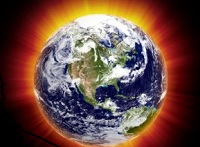New Report Examines Risks of 4 Degree Hotter World by End of Century
 The world is barreling down a path to heat up by 4 degrees at the end of the century if the global community fails to act on climate change, triggering a cascade of cataclysmic changes that include extreme heat-waves, declining global food stocks and a sea-level rise affecting hundreds of millions of people, according to a new scientific report released today that was commissioned by the World Bank.
The world is barreling down a path to heat up by 4 degrees at the end of the century if the global community fails to act on climate change, triggering a cascade of cataclysmic changes that include extreme heat-waves, declining global food stocks and a sea-level rise affecting hundreds of millions of people, according to a new scientific report released today that was commissioned by the World Bank.All regions of the world would suffer - some more than others - but the report finds that the poor will suffer the most.
Turn Down the Heat, a snapshot of the latest climate science prepared for the World Bank by the Potsdam Institute for Climate Impact Research (PIK) and Climate Analytics, says that the world is on a path to a 4 degree Celsius1 (7.2 degrees Fahrenheit) warmer world by end of this century and current greenhouse gas emissions pledges will not reduce this by much.
The report says that the 4°C scenarios are potentially devastating: the inundation of coastal cities; increasing risks for food production potentially leading to higher under and malnutrition rates; many dry regions becoming dryer, wet regions wetter; unprecedented heat waves in many regions, especially in the tropics; substantially exacerbated water scarcity in many regions; increased intensity of tropical cyclones; and irreversible loss of biodiversity, including coral reef systems.
The report summarizes a range of the direct and indirect climatic consequences under the current global path for greenhouse gas emissions. Key findings include:
Extreme heat waves, that without global warming would be expected to occur once in several hundred years, will be experienced during almost all summer months in many regions. The effects would not be evenly distributed. The largest warming would be expected to occur over land and range from 4° C to 10° C. Increases of 6° C or more in average monthly summer temperatures would be expected in the Mediterranean, North Africa, Middle East and parts of the United States.
Sea level-rise by 0.5 to 1 meter by 2100 is likely, with higher levels also possible. Some of the most highly vulnerable cities are located in Mozambique, Madagascar, Mexico, Venezuela, India, Bangladesh, Indonesia, the Philippines and Vietnam.
The most vulnerable regions are in the tropics, sub-tropics and towards the poles, where multiple impacts are likely to come together.
Agriculture, water resources, human health, biodiversity and ecosystem services are likely to be severely impacted. This could lead to large-scale displacement of populations and consequences for human security and economic and trade systems.
Many small island states may not be able to sustain their populations.
The report states that the science is unequivocal that humans are the cause of global warming, and major changes are already being observed. The global mean temperature has continued to increase and is now about 0.8°C above pre-industrial levels.
While a global warming of 0.8°C may not seem large, the report notes that many climate change impacts have already started to emerge, and the shift from 0.8°C to 2.0°C warming or beyond will pose much larger challenges.
But a global mean temperature increase of 4°C approaches the known historic level of change for the planet, which harks back to the last ice age when much of central Europe and the northern United States were covered with kilometers of ice and global mean temperatures were about 4.5°C to 7°C lower. And this contemporary human-induced climate change, the report notes, is occurring over a century, not millennia.
“A 4 degree warmer world can, and must be, avoided - we need to hold warming below 2 degrees,” said World Bank Group President Jim Yong Kim.
“The Earth system’s responses to climate change appear to be non-linear. If we venture far beyond the 2 degrees guardrail, towards the 4 degrees line, the risk of crossing tipping points rises sharply. The only way to avoid this is to break the business-as-usual pattern of production and consumption.” PIK Director, John Schellnhuber.
The report notes, however, that a 4°C world is not inevitable and that with sustained policy action warming can still be held below 2°C, which is the goal adopted by the international community and one that already brings some serious damages and risks to the environment and human populations.
“The world must tackle the problem of climate change more aggressively,”Kim said.”Greater adaptation and mitigation efforts are essential and solutions exist.We need a global response equal to the scale of the climate problem, a response that puts us on a new path of climate smart development and shared prosperity. But time is very short.”
Those initiatives could include: putting the more than US$ 1 trillion of fossil fuel and other harmful subsidies to better use; introducing natural capital accounting into national accounts; expanding both public and private expenditures on green infrastructure able to withstand extreme weather and urban public transport systems designed to minimize carbon emission and maximize access to jobs and services; supporting carbon pricing and international and national emissions trading schemes; and increasing energy efficiency - especially in buildings - and the share of renewable power produced.
You can return to the main Market News page, or press the Back button on your browser.

